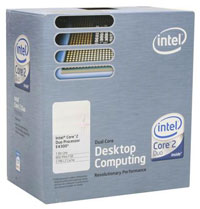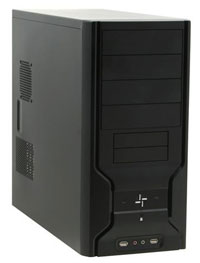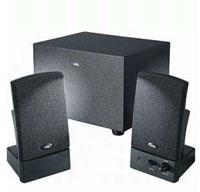Entry Level Intel
Our entry level Intel configuration contains many of the same components as the AMD configuration. The only actual changes are in the choice of motherboard and processor. However, trying to make the systems "equivalent" was simply not realistic. We could either cut the costs of the processor dramatically by going with an older Pentium D offering - not something we would recommend these days - or we end up spending more due to higher prices of Core 2 Duo parts. Intel should be releasing some additional budget offerings in the future, including some single core chips that use the Core architecture. Regardless, if you're looking at Intel-based computers these days we would invariably opt to spend the money and get a Core 2 Duo.
| Intel Entry Level System |
| Hardware |
Component |
Price |
Rebates |
| Processor |
Intel Core 2 Duo E4300 (1.80GHz 2MB Shared) - Retail |
$135 |
|
| Motherboard |
MSI G965M-FI (LGA 775 965G) |
$90 |
|
| Memory |
WINTEC AMPO 2x512MB DDR2-800 (5-5-5-12 3AMD2800-1G1K-R) |
$65 |
|
| Hard Drive |
Western Digital Caviar SE16 WD2500KS 250GB 16MB |
$70 |
|
| Optical Drive |
Lite-On 20X DVD+R LH-20A1P-185 |
$34 |
|
| Case |
RAIDMAX APEX ATX-802BP with 450W PSU |
$65 |
|
| Display |
Hanns-G JC-199DPB 19" 8ms (1280x1024) |
$184 |
$40 |
| Speakers |
Cyber Acoustics CA3001WB 14 watts 2.1 Speakers |
$24 |
|
| Keyboard and Mouse |
Microsoft Comfort Curve 2000 B2L-00047 |
$28 |
|
| Operating System |
Windows MCE 2005 or Vista Home Premium (OEM) |
$115 |
|
| Bottom Line |
|
$810 |
$770 |
 |
Given that price is a major consideration for any budget computer, there was really only one reasonable choice for the processor given the above statements. The Core 2 Duo E4300 is still more expensive than what we would generally classify as an entry level component, but that doesn't mean it isn't worth the money. In pretty much any benchmark you throw at it, the E4300 is going to end up faster than the Athlon X2 3600+ we used in our AMD configuration. Of course, if you were to go out and purchase a $135 AMD part, the performance advantage will likely swing the other way.
 |
Not only do you have to generally spend more money on the processor for the Core 2 Duo platform, but motherboards also tend to cost more than roughly equal offerings from the AMD camp. Since we're using integrated graphics for our entry level configurations, things get even trickier. The IGP offerings for socket AM2 are at present much better than the IGP offerings for socket 775. They perform better, and perhaps more importantly they do so while costing less money. That's not to say that you can't find inexpensive Core 2 Duo compatible motherboards; there are quite a few VIA chipset solutions. For overall quality and reliability, however, we prefer to avoid those if possible, as they can be a bit quirky at times. Motherboards are simply too critical of a component in our view.
Given the choices, we eventually decided to stick with the standard Intel G965 chipset. Graphics performance is subpar compared to the current AMD and NVIDIA offerings, but even then it's still sufficient for most tasks. Intense 3D gaming is not one of those tasks, and even at low resolutions and low detail settings there are so games that won't work properly on this chipset. The X3000 graphics core is supposed to be much improved over previous Intel solutions, but our own opinion is that it remains a lackluster offering. Outside of gaming, however, there are very few applications that require more graphics processing power.
 |
Looking at the G965 motherboards currently available, even the most basic models start at closer to $90, with some of the better equipped models costing as much as $130. The MSI G965M-FI we selected is one of the least expensive offerings but it still does quite well in the features department. Naturally the motherboard supports all Core 2 Duo processors currently available, though it lacks overclocking support in the BIOS at this time. This MSI board also includes FireWire support, something that our entry level AMD platform lacks.
The Gigabyte GA-965GM-S2 would be a better choice for IGP and overclocking, typically reaching moderate FSB speeds. The E4300 processor should be able to run at 2.4GHz (9x266) quite easily and perhaps even 3.0GHz (9x333). Overclocking certainly isn't our primary concern, but the low-end Core 2 Duo chips manage it so well that it deserves mention.
The remaining components are the same, and the bottom line is that the Intel configuration ends up costing about $70 more than the AMD setup. The base performance will definitely favor the Intel platform in processor tests, while graphics tests will favor the 690G IGP over the G965. If you were to spend the same amount of money on both platforms, you could move up to an Athlon X2 5000+ which would certainly put the AMD platform in the lead in virtually all benchmarks. Overclocking would still favor the Intel platform for CPU performance, but for your typical budget PC right now we would give the edge to the AMD platform offerings.














46 Comments
View All Comments
Gary Key - Friday, April 20, 2007 - link
We debated this choice. We feel like the Biostar 690G board is an excellent choice and is probably our favorite 690G board although the Sapphire board has been impressive with the latest BIOS release. The debate originally was to spend a little less on the Asus board and get the 3800+ X2 instead of the 3600+ X2, in the end it was the Asus/3600+ and moving up to a nice 19" monitor to come in under $700.OrSin - Friday, April 20, 2007 - link
Sorry but buying the slow C2D and then pairing it with $70 HSF to me is counter productive. Why spend almost 60% of the CPU+hsf combo on cooling. The intel stock cooler with a faster CPU will still OC fine and get to atleast the same speeds and the 4300. With more head room and lower voltage. Also their are several after market HSF that cost under $30 that work great. Sorry I dont see paring this monster HSF with the lowest CPU.iluvdeal - Monday, April 23, 2007 - link
I'm thinking the same thing, the escalating cost of some HSFs are muting the price/performance you are getting out of your CPU. You might as well spend that extra $70 on a higher CPU and just use the stock HSF.Maybe AnandTech can do an article involving much overclock you get for your money? For example, if you can achieve a 20% OC for "free" using the stock HSF, how does that overclock increase as the price of the HSF goes up?
AnnonymousCoward - Sunday, April 22, 2007 - link
60%? Try 34%. 70/(135+70)MarxMarvelous - Friday, April 20, 2007 - link
I agree - especially when you can get a Scythe Ninja for $40.http://www.newegg.com/product/product.asp?item=N82...">http://www.newegg.com/product/product.asp?item=N82...
JarredWalton - Friday, April 20, 2007 - link
Different strokes for different folks....I like to get a top-quality HSF if I'm serious about overclocking, and I'd say there's a reasonable chance you *won't* get 3.6GHz out of the E4300 without it - about 50/50 depending on CPU. As for cost, an E6400 with Scythe Ninja as an example will end up costing a bit more, but to 3.6GHz you will also need a board and RAM that can run at 450 FSB/DDR2-900 without issues. More likely than not, you will end up spending more money on the RAM just to be safe, and in the end performance is about the same.
Anyway, we have our separate review sections for a reason, and people still don't come to a single consensus on individual parts. When you have to then put together a complete build, every little decision can be debated. Going with a Tuniq 120 for $50 seems like a better idea than a Scythe Ninja if you don't want the Ultra 120. I just like the fact that you get to choose a fan that suits your needs with the Ultra 120 - either for quiet or for maximum OC or somewhere in between. The heatsink only runs about $50, but I figured another $10-$20 for the fan is typical.
OrSin - Friday, April 20, 2007 - link
Oh yeah still good article. It give people a very good picture of where things are.mostlyprudent - Friday, April 20, 2007 - link
Did I miss it, or is there no discussion of the Raidmax case in the article? Anyone know which brand PSU that case uses?Zepper - Sunday, April 22, 2007 - link
The PSU in the Raidmax Apex - I can't read the "E" number under the RU seal so I could check it out on the UL.com site. IAC, it's a junk-bucket with less than half its watts available on its one +12 rail - not even designed for a modern system where the 12V rail is king. For some reason Jarred never acts as if the PSU is the cornerstone of a stable system. I'd be ashamed if I was Jarred.He got lucky on the fancer system as the PSU in the Athenatech is made by Topower. Not great by any stretch, but not a junk-bucket either.
.bh.
Chunga29 - Sunday, April 22, 2007 - link
It's a budget PC for God's sake! Look at the components and tell me with a straight face that even a low-end PSU is going to fail to provide enough power. If you can do that, then I have the name of a shrink that can help with your uhnealthy PSU obesession. IGP + no overclocking + 1 drive = about 110W power draw.